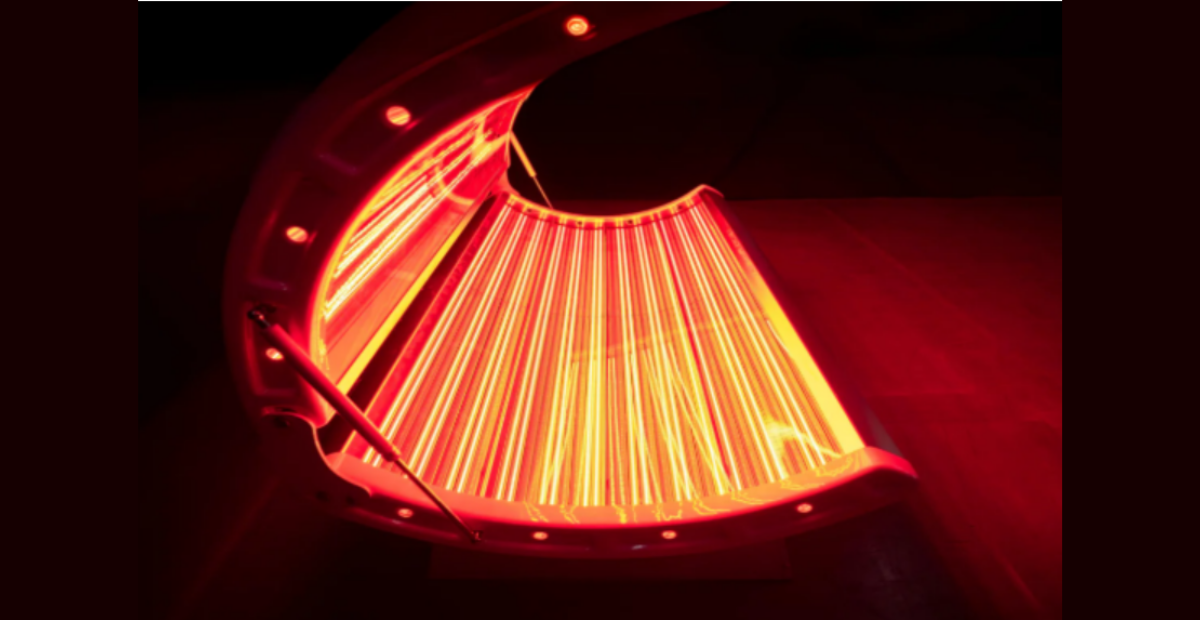Using red light therapy for pain is quickly gaining recognition as a non-invasive, drug-free option for those struggling with chronic discomfort. Whether it’s arthritis, inflammation, or post-workout muscle strain, this light-based treatment offers promising relief supported by growing clinical evidence.
This article will discuss how red light therapy works, the science behind its pain-relieving effects, and its benefits for specific conditions like arthritis, inflammation, and muscle recovery. If you’re considering a natural way to ease pain and support your body’s healing process, we invite you to read further to learn more about this topic.
What Is Red Light Therapy?
Red light therapy for pain is a non-invasive treatment that uses low wavelengths of red and near-infrared light to support the body’s natural recovery process. Originally developed for wound healing and muscle regeneration, it has become a popular option for managing chronic and acute pain.
This type of therapy works by delivering light energy deep into tissues, where it stimulates mitochondrial activity and cellular repair. By enhancing energy production (ATP) at the cellular level, red light therapy helps reduce inflammation, ease discomfort, and support faster healing from injuries or overuse.
How Red Light Therapy Reduces Pain
The primary mechanism of red light therapy relief lies in its ability to reduce inflammation and oxidative stress while stimulating circulation and tissue regeneration. Here's how it helps:
-
Reduces inflammation: By lowering pro-inflammatory cytokines, it helps relieve stiffness and swelling.
-
Improves blood flow: Enhanced circulation allows oxygen and nutrients to reach injured areas faster.
-
Accelerates cellular repair: Mitochondrial stimulation helps rebuild damaged tissues.
-
Decreases nerve sensitivity: Red light therapy may reduce the excitability of pain receptors.
This combination of effects makes red light therapy for pain useful across a wide spectrum of musculoskeletal issues.
Conditions Red Light Therapy Helps With

Before diving into how this treatment can ease discomfort, it’s important to understand what red light therapy is. This science-backed approach uses specific light wavelengths to stimulate healing at the cellular level, offering a natural and non-invasive option for pain relief and tissue repair.
1. Arthritis
Both osteoarthritis and rheumatoid arthritis sufferers have found relief using red light therapy for pain. The light reduces joint inflammation, eases stiffness, and improves range of motion. Studies have shown significant pain reduction after several weeks of consistent use.
2. Inflammation
Chronic inflammation is at the root of many pain disorders. Whether it stems from injury, autoimmune responses, or overuse, red light therapy helps mitigate these responses by calming inflammatory markers in the body.
3. Muscle Strain and Soreness
Athletes and active individuals use red light therapy for pain to speed up recovery after training. It reduces muscle fatigue, shortens recovery time, and eases post-exercise soreness by increasing circulation and reducing microtrauma.
4. Back and Neck Pain
Back and neck pain caused by poor posture, herniated discs, or tension can be significantly relieved with regular red light sessions. The therapy penetrates deep into tissues to relax muscles and reduce tension.
5. Tendonitis and Joint Issues
Conditions like tennis elbow, carpal tunnel, and knee tendonitis also benefit from red light therapy. It can be used as a complementary treatment to physical therapy or on its own for mild to moderate symptoms.
Scientific Studies Supporting Red Light Therapy for Pain
Numerous peer-reviewed studies back the use of red light therapy for pain management. Some highlights include:
-
A 2017 review in Pain Research and Management concluded that red light therapy significantly reduces pain in arthritis patients compared to placebo treatments.
-
A 2020 randomized trial published in Lasers in Medical Science found that athletes using red light therapy recovered faster and experienced less post-exercise soreness than those who didn’t.
-
Research from Photomedicine and Laser Surgery demonstrated improved neck pain scores and mobility after consistent red light therapy sessions.
These findings reinforce that red light therapy for pain is not just a trend; it’s a science-backed solution with real results.
Best Red Light Therapy Devices for Pain Relief
When choosing a device, it’s important to consider factors such as wavelength, coverage area, and power output. Here are a few top-tier recommendations:
Epoch® 980nm Red Light Helios Portable Pain Management Device

Designed for deep tissue penetration, the Epoch Helios is compact yet powerful, making it ideal for users targeting joint or muscle pain. Its 980nm wavelength goes deeper than traditional red light options, ideal for chronic pain.
Airvida Aura Red Light Therapy Bed

This full-body red light therapy bed provides a comprehensive treatment session in minutes. It covers large surface areas at once, making it suitable for individuals dealing with widespread inflammation or post-exercise recovery.
Airvida Radiance Red Light Therapy Bed

The Airvida Radiance offers advanced red and near-infrared settings with adjustable intensity, making it ideal for clinics or dedicated home users seeking consistent, full-body pain relief. Built for comfort and performance, it’s a premium option for long-term red light therapy support.
Airvida X Dr. Mueller Red Light + Vibration Plate

Combining red light with vibration therapy, this device boosts circulation and accelerates pain relief. It’s especially effective for easing joint stiffness, muscle tightness, and post-exercise recovery, making it a smart, compact solution for home or professional wellness use.
Each of these options is optimized for users who rely on red light therapy as part of their wellness routine.
Benefits and Limitations
Benefits
-
Non-invasive and drug-free: No prescriptions, no surgeries, just natural healing.
-
Minimal side effects: Most users tolerate red light therapy well, with virtually no downtime.
-
Easy to use at home: With portable devices, daily treatments are convenient and accessible.
-
Science-backed efficacy: Supported by clinical trials and scientific research.
Limitations
-
Requires consistency: It’s not a one-time fix. You’ll need regular sessions to see lasting results.
-
Upfront cost: Quality devices can be expensive, though they are a long-term investment.
-
Limited effect on acute trauma: It works best for chronic or lingering conditions rather than fresh injuries.
Despite these limitations, red light therapy for pain continues to grow in popularity due to its ease of use and reliability.
How to Use Red Light Therapy for Best Results

To get the most out of red light therapy for pain, follow these basic tips:
-
Start with 3–5 sessions per week, lasting 10–20 minutes per session.
-
Keep the light source around 6–12 inches away for optimal absorption.
-
Expect to see results within 2–4 weeks of regular use.
-
Make sure the painful area is exposed directly to the light without heavy clothing.
Avoid overexposure; more isn't always better. Always follow the manufacturer’s instructions to avoid skin sensitivity or overheating.
Final Thoughts
In a world where wellness tools are becoming smarter and more accessible, more people are seeking treatments that empower the body’s natural ability to heal. With advancements in non-invasive technology and a growing emphasis on preventative care, new options are emerging that make self-care both effective and convenient.
If you’ve been dealing with arthritis, post-workout soreness, or chronic inflammation, red light therapy for pain may be the safe and effective treatment you’ve been looking for. It’s a science-backed way to feel better without medication or surgery. Consider exploring your options today and experience the relief that so many others have already discovered.
Frequently Asked Questions for Red Light Therapy for Pain Relief
Is red light therapy safe for pregnancy?
It’s best to avoid red light therapy during pregnancy unless approved by a healthcare provider.
Does red light therapy work for dogs?
Yes, red light therapy is often used for dogs to reduce pain, inflammation, and support healing.
Who cannot use red light therapy?
People with light sensitivity, active cancers, or those taking photosensitizing medications should avoid it.
Does red light therapy work for arthritis pain?
Yes, studies show it can reduce joint pain and stiffness associated with arthritis.
How long does red light therapy take to work for pain?
Some users feel relief after a few sessions, while others may need consistent use for several weeks.
You May Also Read These Articles:
Red Light Therapy for Face Conditions: Natural Healing Explained
5 Factors That Set Professional Red Light Therapy Devices Apart From Other Machines
Red Light Therapy Bed: 4 Key Differences Between Airvida Chambers’ RLT Beds
Disclaimer
Airvida and partners advice does not constitute medical advise and is intended for informative and educational purposes only with no medical or non medical claims being made. While research & studies show the potential Hyperbaric Oxygen Therapy (HBOT) and Hyperbaric Air Therapy (HBAT) may have implied benefits, individual results may vary. It is required by Airvida & Partners to console with doctors before being approved for Hyperbaric Therapy (HBOT & HBAT). Read More HERE




